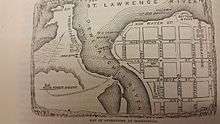Battle of Ogdensburg
The Battle of Ogdensburg was a battle of the War of 1812. The British gained a victory over the Americans and captured the village of Ogdensburg, New York. Although small in scale, it removed the American threat to British supply lines for the remainder of the war.
Background
When the war broke out, a flourishing illicit trade was soon established between Ogdensburg and Prescott, Upper Canada (later to become the province of Canada West in 1841), on the Northern side of the Saint Lawrence River. This was checked early in October 1812 when the Americans reinforced the militia with some of the regular 1st U.S. Rifle Regiment under Major Benjamin Forsyth.
The British made an abortive attack with their own militia on October 3, which was quickly repulsed by the American forces in Ogdensburg, after which the militia dispersed. During the next few months, Forsyth's riflemen made several raids across the river, sniping at British troops and occasionally capturing boatloads of supplies on their way to Kingston, Ontario.
On February 21, 1813, Lieutenant General Sir George Prevost, the British Governor General of Canada, passed through Prescott on his way to review the situation in Upper Canada, accompanied by several detachments of reinforcements. He appointed Lieutenant Colonel "Red George" MacDonell as commandant of British troops in Prescott and left him instructions that he was to attack Ogdensburg only if the Americans weakened their garrison.
The reinforcements, although there temporarily, allowed MacDonnell to improvise. He planned for a company of the Glengarry Light Infantry, 70 militia and some light guns mounted on sleighs to make a frontal attack on the fort which housed Forsyth's riflemen. The main column, consisting of 120 men of the 8th (King's), 30 of the Royal Newfoundland Fencibles and 230 of the local militia flank companies, would cross the river lower down and attack from the flank.
Battle

The Americans were used to seeing British troops drilling on the frozen Saint Lawrence and were taken by surprise when they suddenly charged. The riflemen in the fort held out against the frontal attack, mainly because the British guns became stuck in snow drifts, and American artillery, under Adjutant Daniel W. Church of Colonel Benedict's regiment and Lieutenant Baird of Forsyth's company, fired on the British with mixed results. As the British main body threatened to surround them, they retreated and abandoned the town. The militia retreated back into the civilian population. The artillery under Church and Baird managed to put up a tough resistance until both Church and Baird were wounded. The British then took control of the town.
The British burned the boats and schooners frozen into the ice, and they carried off artillery and military stores. There was some looting of private property, but some of the plundered goods were later returned.
Casualties
The British casualty return listed two British regulars, two Glengarry Light Infantry and two militiamen killed; 12 British regulars, 12 Glengarry Light Infantry and 20 militiamen wounded; for a total of six killed and 44 wounded.[1]
Lieutenant Colonel Macdonell reported that 20 Americans were killed and 70 captured, of whom many were wounded.[2] An American account gave their loss as 26 killed and wounded and about 60 taken prisoner,[3] a figure which suggests that only six of the wounded men escaped capture.
Aftermath
After the British withdrew, the Americans did not re-garrison Ogdensburg. The British were able to purchase supplies from Americans merchants there for the remainder of the war. The Ogdensburg area may have been populated by more Tories and Federalists than was previously thought.
The normally cautious Prevost amended MacDonell's despatch to make it appear that the attack had been carried out on, rather than against, his orders.
The regimental Chaplain of the Glengarry Light Infantry, Alexander Macdonell, is reputed to have accompanied the attack, wielding a crucifix to encourage lagging soldiers. He was supported by Presbyterian minister the Rev. John Bethune of Williamstown.
Notes
- Cruikshank, p. 79
- Johnston, p. 100
- Cruikshank, p. 77
References
- Cruikshank, Ernest (1971) [1902]. The Documentary History of the Campaign upon the Niagara Frontier in the Year 1813. Part 1: January to June, 1813. New York: The Arno Press Inc. ISBN 0-405-02838-5.
- Hitsman, J. Mackay,The Incredible War of 1812, University of Toronto Press, ISBN 1-896941-13-3
- Johnston, Winston (1998). The Glengarry Light Infantry, 1812-1816. Charlottetown, Prince Edward Island: Benson Publishing. ISBN 0-9730501-0-1.
- Latimer, Jon, '1812: War with America, Harvard University Press, 2007, ISBN 0-674-02584-9
